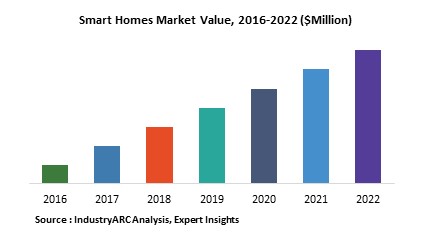Smart Homes Market - Forecast(2020 - 2025)
Smart Homes Market Overview:
Expanding human population is inversely proportional to the amount of natural resources present on earth. The world’s non-renewable energy resources are depleting, while demand for power is increasing. As per United States Energy Information Administration, global energy requirement is expected to rise by 28% by the year 2040. This statistic is alarming in accordance with the ever-increasing human population that is consuming energy at an extraordinary rate owing to technological advancement. In a region like Asia where automotive and electronics industries have taken center stage, countries including India and China account for more than 60% of the expected 28% increase in global energy requirement. Smart technological systems, thus, have become the need of the hour. Key players in the renewable resources market, and government officials around the world have exhorted all kinds of industries to come up with sustainable technological systems that conserve environment while keeping the smooth functioning of our daily lives intact.
Smart homes is one such noticeable invention in a series of sustainable products which have been recently unveiled in the global market. Using the Internet of Things technology, smart homes utilize automation, and simplify our home environments to a large extent. The global smart homes market size in 2018 was estimated to be between $70 billion to $75 billion.
The smart homes market is expected to grow with an outstanding CAGR of 15% during the forecast period of 2019-2025. This is largely credited to North America which holds a regional smart home market share of 28%. Automation, and electronic companies in North America are leaving no stone unturned in bolstering the market growth.
Smart Homes Market Outlook:
Any house that uses home automation technology is called a smart home. On entering a smart home, one can see connectivity on nearly all devices. Internet of Things, the ability to impart connectivity to any non-internet-enabled device is the building block of a smart home. Through that, one can sit back and control everything in their house with a remote control, thus making human life simpler, and better. Nearly all the devices like thermostats, water detectors, yale locks, smart sensors, humidifiers, smoke alarms, wireless doorbells are connected to a person’s personal phone or tablet, through which they can control the devices irrespective of whether they’re inside the home, or outside it. Key players in the market are investing extensively in this technology, and are coming up with newer products that could supplement home automation technology. Google Home, a set of speakers released by Google in 2016 enable a user to control their home’s environment simply through a voice command.
Smart Homes Market Growth Drivers:
A Helping Hand for the Handicapped Society
According to the World Bank, around one billion people in the world have experienced some or the other kind of disability. Facing difficulty in accessibility is an everyday phenomenon for handicapped people, and they are comparatively more susceptible to socioeconomic outcomes. Needless to say, smart homes is a one-step solution for them to lead a comfortable lifestyle. Through smart homes, they can easily control their house’s environment without facing much difficulty in mobility. Smart homes also benefit the geriatrics population tremendously by reducing a need for a manual helping hand, and simplifying things for them at the touch of a button. Smart homes market generates high demand from all architectural structures involving the handicapped, and geriatrics population.
Smart Homes Market Challenges:
The biggest challenge faced by the smart homes market is security risk. Since nearly everything in a smart home is connected to the internet, there is an increased threat of cyber-crime. Every device in a smart home can easily convey the whereabouts, and usage time of the owner. Data of this magnitude makes the user completely vulnerable to cyber-attacks, putting their lives at risk. Viewing smart home cyber security as a primary goal while designing smart home technology is the way to combat this challenge.

- Smart Homes Are Eco-Friendly
- Give a deep-dive analysis of the key operational strategies with focus on the corporate structure, R&D strategies, localization strategies, production capabilities, and sales performance of various companies
- Provide an overview of the product portfolio, including product planning, development, and positioning
- Discuss the role of technology companies in partnerships
- Explore the regional sales activities
- Analyze the market size and giving the forecast for current and future global the Smart Homes market during the forecast 2018–2023
- Analyze the competitive factors, competitors’ market shares, product capabilities, and supply chain structures
- We also publish more than 100 reports every month in “Information and Communications Technology”, Go through the Domain if there are any other areas for which you would like to get a market research study.
Comments
Post a Comment